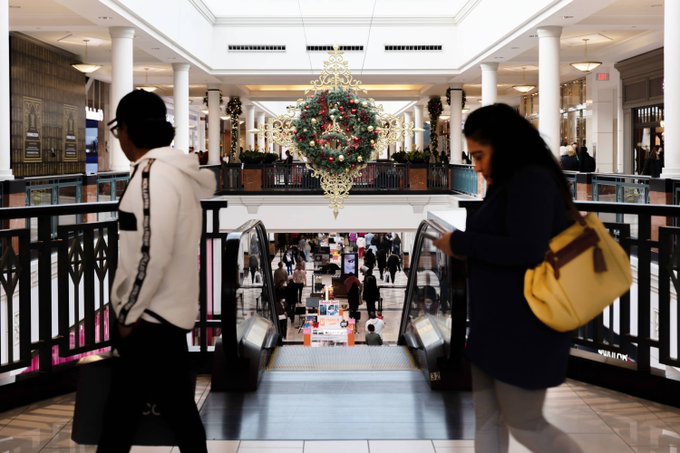- Holiday spending rose 8.5% compared with the year-earlier period, according to Mastercard SpendingPulse.
- In-store sales added 2.4% and online sales surged 61.4% compared with the pre-pandemic period of 2019.
- Apparel and jewelry were standout categories even when compared with holiday spending two years ago.
As shoppers kick off a wave of returns and exchanges or rush in to spend gift cards, retailers appear to have reason to celebrate: Holiday spending rose 8.5% compared with a year ago, according to Mastercard SpendingPulse.
The gain was slightly less than the 8.8% increase that Mastercard had predicted, but it was the biggest annual increase 17 years. Still, some are concerned that a strong holiday season could set up a more challenging January and February.
“Consumer demand remains very strong, but we’re cautiously optimistic because the traffic has decelerated a little bit in December,” said Oliver Chen, a retail analyst for Cowen, on CNBC’s “Squawk on the Street.”
Chen said he still has tempered expectations for the industry’s performance this holiday season and beyond. Inflation and the Covid omicron variant are weighing on consumers’ minds at the same time that supply chain challenges are posing business pressure. In the event that shoppers’ appetites wane or goods arrive at the wrong time, it would force retailers to increase markdowns.
Retail consultant Jan Kniffen, on the other hand, said he has been impressed by consumers’ willingness to keep spending and retailers’ ability to put up big numbers, despite a complex backdrop of congested ports, labor shortages, wage increases and more.
On CNBC’s “The Exchange” on Monday, he said the past two months may go down as the “best holiday selling ever.”
Kniffen, a former executive at The May Department Stores, which was eventually folded into Macy’s, said he expects momentum to continue in the next few weeks and even into the first half of 2022. He said an an increase in gift cards will buoy purchases in the last week of December and early January. Gift cards do not count toward retail sales until people redeem them.
He said the tighter labor market makes people feel more confident and financially secure. Plus, he anticipates the new variant will inspire people to keep buying goods rather than shifting to services, like vacations, manicures or movie tickets.
“We could continue to see really strong sales of things as opposed to experiences right through the first half,” he said. “Omicron has slowed down experiences, but it hasn’t slowed down things at all.”
Retailers and investors are just starting to get a read on the peak shopping season. The Mastercard data, one of the first looks at the season, tracks in-store and online retail sales from Nov. 1 through Dec. 24 across all forms of payment, excluding automotive sales.
By its measure, retail sales significantly exceeded pre-pandemic levels, with total sales increasing 10.7% this holiday compared with the same time in 2019. In-store sales grew 2.4% and online sales surged 61.4% versus the two-year-ago period.
Since the pandemic, online shopping has become a common holiday-shopping habit. E-commerce sales jumped 11% from 2020 to 2021, according to Mastercard. Online sales made up nearly 21% of total retail spending, roughly in line with the year-earlier period and up from 14.6% in 2019.
Some retail categories especially shined. Apparel sales and jewelry sales rose 47.3% and 32%, respectively, versus the year-ago period. They were up 29% and 26.2% when compared with the holiday season in 2019. Electronics sales jumped 16.2% compared with the year-ago period.
Chen said some retailers, including Walmart, Costco and Target, are better positioned than others because they cut across merchandise categories and have online business options, such as curbside pickup and home delivery, as people look for convenient and safe ways to shop. Walmart and Target shares were both trading up less than 1% in trading Monday, while Costco shares gained more than 2%.
Luxury retailers, including jeweler Brilliant Earth and high-end home decor retailer RH, have benefited from less price sensitive consumers who are splurging on earrings, handbags, pricey furniture and more, he said. Shares of both Brilliant Earth and RH were slightly lower in trading Monday.
Chen added that Macy’s and Kohl’s are appealing stocks because the shares have underperformed. On Monday, Macy’s was up more than 3%, while Kohl’s gained nearly 2%. After a tough year for department store stocks in 2020, Macy’s is up 131% year to date. Kohl’s has gained more than 25% since the start of 2021.

